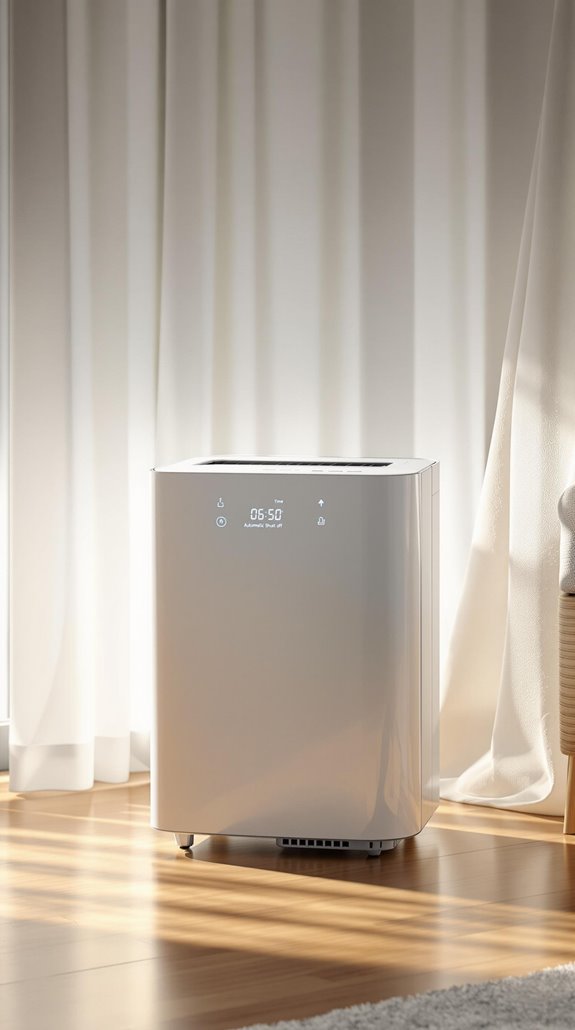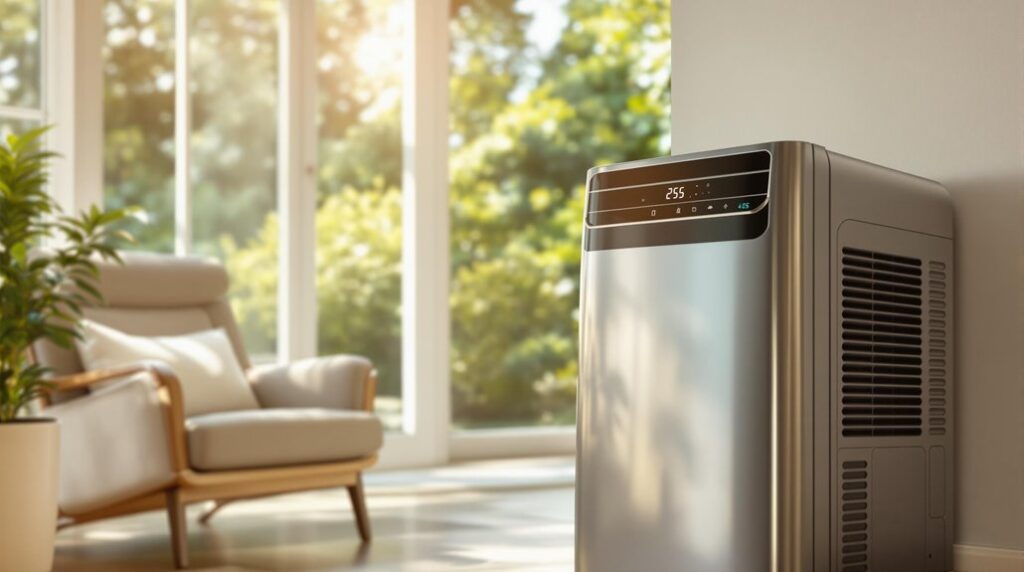I’ve helped countless homeowners slash their dehumidifier energy bills by understanding one essential factor: runtime optimization. Most people run their units 24/7, thinking it’s necessary, but you’re likely wasting hundreds of dollars annually. The truth is, your dehumidifier’s daily runtime depends on three specific variables that most manufacturers won’t tell you about. Once you master these factors, you’ll cut your operating costs by up to 60% while maintaining perfect humidity levels.
Key Takeaways
- Dehumidifiers should run 8-12 hours daily for high humidity (>60%) and 6-8 hours for moderate humidity levels.
- ENERGY STAR certified units consume 15-30% less energy than standard models, reducing daily operating costs significantly.
- Use smart timers and automatic shutoff at 50-55% humidity to save 10% energy per 5% increase.
- Summer requires 6-8 hours of operation while cooler months need only 2-4 hours daily.
- Schedule operation during off-peak electricity hours and maintain coils regularly to maximize energy efficiency.
Optimal Daily Runtime Based on Humidity Levels and Room Size
Two primary factors determine how long your dehumidifier should run each day: the humidity levels in your space and the room’s size. I’ve found that most dehumidifiers operate efficiently between 8 to 12 hours daily, but your specific runtime depends on these key variables.
When humidity exceeds 60%, you’ll need longer runtimes—potentially up to 12 hours—to reach your target levels of 40-50%. For spaces with moderate humidity, 6-8 hours typically suffices. Room size dramatically impacts runtime too. Larger spaces require extended operation for proper air circulation and moisture removal, while smaller rooms may achieve target humidity in just 2-4 hours.
The critical factor is matching your unit’s capacity to your room size. An undersized dehumidifier will run continuously without achieving desired results, wasting energy and shortening its lifespan. Proper capacity selection prevents mold growth and ensures your dehumidifier operates efficiently within its designed parameters.
Understanding Energy Consumption and Cost Calculations
While runtime considerations help you optimize performance, understanding the financial impact of your dehumidifier’s operation is equally important for making informed decisions. I’ll break down the energy consumption patterns that directly affect your electricity bill.
Smaller 30-pint units consume 300-360 watts, while larger 70-pint models use 600-700 watts. Running a typical unit 8 hours daily translates to 2.4-5.6 kWh of electricity consumption. At average residential rates, this costs approximately $0.34-$0.78 daily.
Your dehumidifier likely accounts for 9% of your home’s total electricity consumption, with annual usage reaching 1,000 kWh or more. That’s roughly double what an ENERGY STAR refrigerator consumes yearly. Units with ENERGY STAR certification provide at least 15% more efficiency than conventional models, helping reduce these operating costs. Calculate your costs using this formula: daily kWh × local electricity rate × 365 days.
Smart Timer Settings and Automatic Shutoff Features

Since managing dehumidifier operation manually throughout the day isn’t practical, smart timer settings and automatic shutoff features provide essential control over your unit’s daily runtime. These systems let you program precise schedules that align with the recommended 2-8 hours of daily operation based on your humidity levels.
Most modern dehumidifiers offer delay start and stop timers ranging from 30 minutes to 24 hours. I’ve found that setting an automatic shutoff timer prevents unnecessary energy consumption while maintaining ideal humidity levels. The device’s automatic regulation works seamlessly with timer functions, adjusting operation as needed.
Smart models with app controls make scheduling even easier. You can set maximum daily runtime limits and let the unit’s sensors determine when active dehumidification is needed within your programmed timeframe. Advanced units with humidity sensors automatically detect moisture levels and adjust their operation accordingly, ensuring optimal performance without manual intervention.
Seasonal Adjustments for Maximum Efficiency
As seasons change throughout the year, your dehumidifier’s settings and operation schedule need corresponding adjustments to maintain ideal efficiency and prevent unnecessary energy consumption.
During hot, humid summer months, I recommend lowering your thermostat setting to 40-50% and extending daily run times to 6-8 hours. This aggressive approach combats peak moisture levels effectively.
When cooler, less humid months arrive, you’ll want to raise settings to 50-60% while reducing operation to 2-4 hours daily. This prevents over-drying your indoor air. Proper seasonal adjustments help maintain a balanced indoor climate and improve air quality throughout your home.
Temperature matters greatly—never operate below 60°F, as moisture freezes on coils and damages components. I suggest completely shutting down and storing units during winter months.
Monitor these adjustments regularly, especially during seasonal changes, to balance ideal dehumidification with energy conservation.
Energy-Saving Strategies That Cut Operating Costs
Because energy costs continue rising nationwide, implementing targeted strategies can reduce your dehumidifier’s operating expenses by 30-50% without sacrificing performance. I recommend starting with ENERGY STAR-certified units that consume 15-30% less energy than standard models. You’ll want to calibrate your humidistat quarterly and set auto-shutoff at 50-55% humidity—each 5% increase saves 10% energy.
Smart scheduling makes a significant difference. Program your unit for off-peak hours when electricity rates drop, and use timers to target high-humidity periods like mornings and evenings. Avoid continuous mode; auto mode reduces daily operation by 3-4 hours. Regular maintenance of coils and air filters enhances efficiency and prevents unnecessary energy waste. Monitor your consumption using this formula: (Wattage × Hours) ÷ 1000 = kWh. Track baselines and adjust runtime weekly based on humidity forecasts to maximize savings.
Conclusion
I’ve found that running your dehumidifier 8-12 hours daily strikes the perfect balance between moisture control and energy efficiency. You’ll want to adjust this based on your room size and humidity levels—smaller spaces need less time, while high-humidity environments require maximum runtime. I recommend investing in an ENERGY STAR model with programmable timers, scheduling operation during off-peak hours, and maintaining your unit regularly. These strategies will greatly reduce your operating costs while maintaining ideal indoor air quality.
References
- https://bloomfold.com/en/blogs/luchtontvochtigers/hoelang-gebruik-je-een-luchtontvochtiger-idealiter-per-dag
- https://moorgen.hk/blogs/moorgenzine/does-running-a-dehumidifier-all-day-waste-electricity-energy-saving-tips-revealed
- https://aircareconnect.com/blogs/air-care-library/how-long-should-a-dehumidifier-run-per-day
- https://woods.se/en/articles/save-electricity-with-a-dehumidifier-find-out-how-here/
- https://www.novakheating.com/should-you-leave-a-dehumidifier-on-all-the-time/
- https://www.abestorm.com/blogs/news/how-long-should-a-crawl-space-dehumidifier-run
- https://www.greenbuildingadvisor.com/question/correct-way-to-run-dehumidifier-year-round-in-a-basement
- https://www.idealhome.co.uk/all-rooms/how-long-should-you-let-a-dehumidifier-run
- https://aloraircrawlspace.com/blogs/news/how-much-electricity-does-a-dehumidifier-use
- https://moisturecurecommercial.com.au/how-much-electricity-does-an-industrial-dehumidifier-use/

